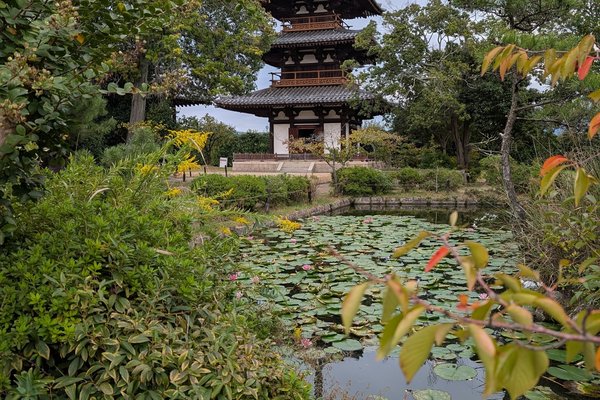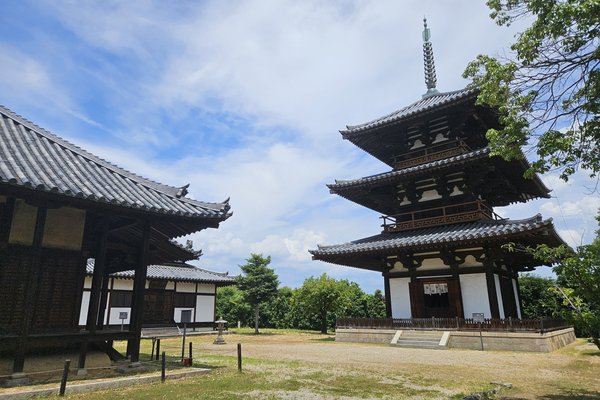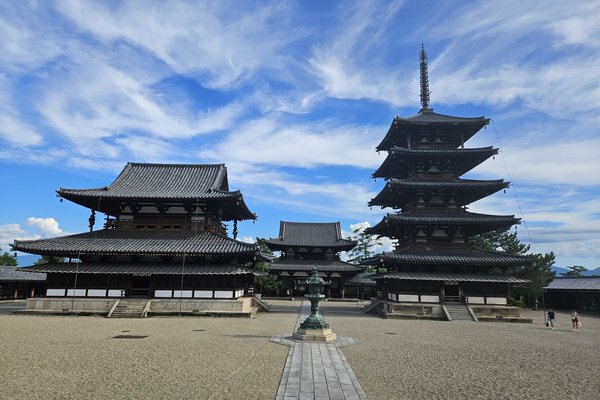Japan
Horyu-ji Area
The Buddhist Monuments in the Horyu-ji Area, masterpieces of wooden architecture, are the earliest of their kind in Japan
Horyu-ji was founded by Prince Shotoku who was the first patron of Buddhism in Japan. Here elements of Chinese Buddhist architecture were adapted into a distinctly Japanese style, which became influential in the rest of Japan. The 48 monuments are spread across two temple sites, Horyu-ji and Hokki-ji.
Community Perspective: more austere than other temples in the Kyoto-Nara area, but these are superbly constructed, most important due to their age and not as busy with tourists. Horyu-ji is the main location of the two.
Site Info
Official Information
- Full Name
- Buddhist Monuments in the Horyu-ji Area (ID: 660)
- Country
- Japan
- Status
-
Inscribed 1993
Site history
History of Horyu-ji Area
- 1993: Inscribed
- Inscribed
- Type
- Cultural
- Criteria
- i
- ii
- iv
- vi
Links
- UNESCO
- whc.unesco.org
- Official
-
- horyuji.or.jp — Official website for Horyu-ji and Hokki-ji
- Related
-
- greatbuildings.com — Link
All Links
UNESCO.org
- whc.unesco.org — whc.unesco.org/
Official Website
- horyuji.or.jp — Official website for Horyu-ji and Hokki-ji
Forum Discussion
- worldheritagesite.org — Getting there from Nara
Related Resources
- greatbuildings.com — Link
News Article
- June 24, 2022 asahi.com — Horyuji temple crowdfunding drive nets over 100 million yen
- Feb. 1, 2015 ajw.asahi.com — Horyuji temple in Nara hikes admission fees following decrease in visitors
Community Information
- Community Category
- Religious structure: Buddhist
Travel Information
Kyoto hotspot
Recent Connections
-
Cultural property cloning
"a copy of Horyuji Temple’s Shakasanzon… -
Kyoto hotspot
1h25 by train / 75km -
Built in the 7th century
Founded in the 7th century, destroyed b…
Connections of Horyu-ji Area
- Trivia
-
-
Tobu World Square
-
On Banknotes
Yumedono; 100 Yen; issue Feb 25, 1946-July 5,1956 and 1000 Yen from 1950
-
- Architecture
-
-
Wooden architecture
-
Octagons
Yumedono
-
- World Heritage Process
-
-
Perfect Inscriptions
1993
-
- Religion and Belief
-
-
Introduction of Buddhism
criteria ii "These are the earliest Buddhist monuments in Japan, dating from shortly after the introduction of Buddhism to the country, and had a profound influence on subsequent religious architecture." (OUV) -
Pagoda
Gojunoto Pagoda (wood) - five stories (32.45 meters); Asuka period
-
- Constructions
-
-
Freestanding Bell Tower
ancient bell tower with same building style as Nikko
-
- Timeline
-
-
Built in the 7th century
Founded in the 7th century, destroyed by fire in 670 and rebuilt almost immediately
-
- WHS Hotspots
-
-
Kyoto hotspot
1h25 by train / 75km
-
- Science and Technology
-
-
Cultural property cloning
"a copy of Horyuji Temple’s Shakasanzon Statue, also known as the symbol of Japonism, whose original is prohibited to be taken out of the premises and is no longer available to the public"
-
News
- asahi.com 06/24/2022
- Horyuji temple crowdfunding drive …
- ajw.asahi.com 02/01/2015
- Horyuji temple in Nara hikes admis…
Recent Visitors
Visitors of Horyu-ji Area
- AC
- Adam Hancock
- Afshin Iranpour
- Alexander Barabanov
- Alexander Lehmann
- Alexander Parsons
- Alex Goh
- Alex Marcean
- AlexSchedel
- Alikander99
- Allan Berry
- Ammon Watkins
- Ana Lozano
- Artur Anuszewski
- Aspasia
- Astraftis
- Atila Ege
- Axel Hansson
- Bamse
- BaziFettehenne
- BenReeve
- Bill Koo
- Bill Maurmann
- BMuramatsu
- Boj
- campmany
- Can SARICA
- Carlo Sarion
- Caspar
- CeeMon
- Celina Nanbara
- Chalamphol Therakul
- chenboada
- chenqtao
- Cheryl
- Christoph
- Christravelblog
- Clyde
- Colossus
- CugelVance
- cutecid
- cwthong
- Cyberczar
- CynthiaW
- Daniel Chazad
- Danny L
- Dimitar Krastev
- DL
- Dr. Caligari
- Elena Y
- Elisabeth Fransisca Situmorang
- Els Slots
- Erik Jelinek
- Errol Neo
- Eva Kisgyorgy
- Fan Yibo
- Feldhase
- Felicité
- Filip Murlak
- Frédéric M
- Frederik Dawson
- GabLabCebu
- Garrett
- Gary Arndt
- GeorgeIng61
- Harald T.
- henrik_hannfors
- henryjiao18
- Hubert
- Iain Jackson
- ivantham
- Jacob Choi
- Jasam
- Jasonfd247
- Jawnbeary
- Jeffrey Chai
- jess4sythe
- JL
- João Aender
- Joel on the Road
- Jonas Hagung
- Jonas Kremer
- Jon Bauer
- Jon Eshuijs
- Joyce van Soest
- Karito Vies
- Kasia M.
- Kasper
- KeithBailey
- Kjsisney
- Kurt Lauer
- lichia
- Loic Pedras
- Lucio
- Ludvan
- Luis Filipe Gaspar
- Luke LOU
- Maciej Gil
- marcel staron
- Matthewsharris
- MaYumin
- M.HATADA
- Michael Turtle
- Miguel Marquez
- Mikan22
- Mikko
- Miloš Tašković
- Mo-han Je
- nan
- Nicolas
- Nihal Ege
- NoahFranc
- _oscar
- Patrik
- Paul Schofield
- Pchxiao
- Peter Lööv
- Petteri
- Philipp Peterer
- phillipmeng
- Porcho
- Ralf Regele
- Randi Thomsen
- ReallyDeepThoughts
- Reza
- Rick Ohm
- Rob Wilson
- Sergio Arjona
- Shandos Cleaver
- sncjob
- Solivagant
- Squiffy
- Stanislaw Warwas
- Stijn
- Svein Elias
- SymonMajewski
- Szucs Tamas
- TaiTT
- takanenohana
- Tamara Ratz
- Taotao Chen
- Tcchang0825
- Thomas Buechler
- Thomas van der Walt
- Thorben
- Tonisan
- Tony H.
- triath
- Truls Brekke
- Tsunami
- Valentina
- Vincent Cheung
- Vsacan
- Westwards
- Wojciech Fedoruk
- Xiong Wei
- Xiquinho Silva
- Yongcheng Liu
- zman5455
- Zoë Sheng
- Zos M
- ZZSong
Community Reviews
Show full reviews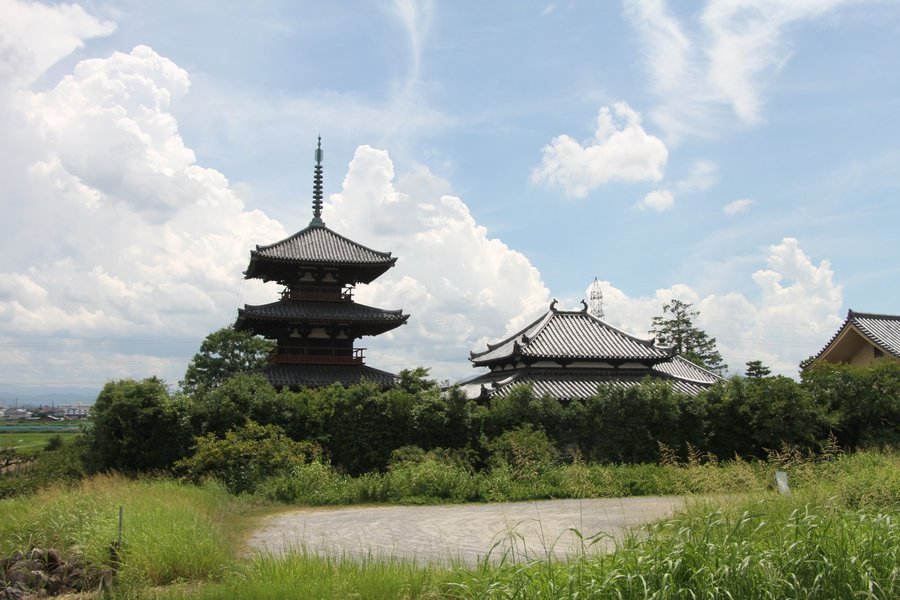
This is a small and quiet area, out of the way and far less of a tourist draw than nearby Nara. While I found the sites in Nara beautiful, the Horyu-ji sites felt more meaningful for me, knowing I was standing in the presence of the oldest wooden structures in the world. You can feel the age of the place and it was incredibly peaceful to simply walk around the grounds and appreciate the beauty and craft in their design and construction. Very easily reachable from either Nara or Osaka for a day trip.
Keep reading 0 comments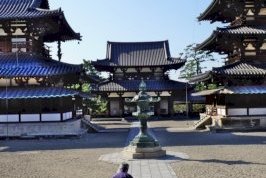
Hōryū-ji is considered the cradle of Japanese Buddhism, the temple is closely linked to the introduction of Buddhism in Japan. Along with the new belief also a different architectural style was introduced. Buddhist temples usually have a strictly symmetrical layout with a gate and the main hall in the central axis, surrounded by a wall. Shinto Architecture, on the other hand, aims to blend in perfectly with nature. And Hōryū-ji is home of the oldest wooden structures in the world. No doubt about its historical significance and reasons enough to inscribe Hōryū-ji as one of the first Japanese world heritage sites in 1993. However, Hōryū-ji receives far less attention from visitors than its famous neighbours Kyoto and Nara.
I visited Hōryū-ji as a half-day trip from Nara. The JR train only takes eleven minutes to Hōryū-ji station, and after a 20-minute walk I arrived at the entrance to the Western Precinct, where the main buildings are located. I was the first visitor at 8.15 am and only had to share the inner temple with the staff who swept the pavements (photo). The most important and most impressive buildings are the main hall or Kondō and the five-story pagoda. The sources are contradictory as to which of the two is older. A Japanese cypress supplied the wood for the central pillar of the pagoda. It has been determined by dendrology that this cypress was felled in 594. Thus, the pagoda seems to be the winner of the title "oldest among …
Keep reading 0 comments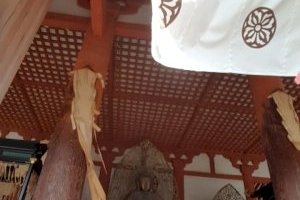
WHS#78
Horyuji is home to the undisputed oldest wooden buildings left in the world today. The Chumon, Kondo, 5-story pagoda, and the surrounding cloister in the Western Precinct were all built and last rebuilt in the Asuka Period, over 1300 years ago. Other structures, like the Western Precinct's Great Lecture Hall and the Yumedono in the Eastern Precinct were last rebuilt over 1000 years ago, as well. Only a church in England and a few temples in China even come close to being a millenium old. And the whole complex has been around for over 1400 years! Enough about age, though, Horyuji is genuinely a very interesting temple complex to see if you're in the Kansai Region. To me, it's more important than any of the temples in Nara, aside from Todaiji, because it's an impressively large complex with an impressive legacy on temple building in Japan. While Todaiji and even Kofukuji are more visually impressive, I find that Horyuji's beauty is extremely underrated. It's also a breath of literal fresh air being away from the city, the tourist crowds, and yes, even the deer. It's just you, yourself, and the temples. And a few smart tourists, sorry. I was lucky enough to visit in December 2019 by taking a bus from JR Horyuji Station. You approach it through a lane of pine trees, which is apparently part of the WHS, before encountering the Nandaimon, the main gate to the complex. It took around an hour to explore, but …
Keep reading 0 comments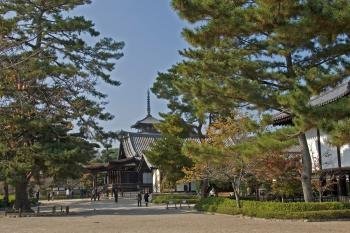
I visited this site in 2007.
Whenever someone tells me they are going to Japan, especially if they are going to Kyoto and Nara, I tell them to take the time to go to Horyuji.
Getting here is simple. It is an easy walk from the train station, and you can visit on a day trip from either Kyoto or Nara.
It is home to the world's oldest wooden buildings. Given the flammable nature of wood, it is remarkable that they have survived as long as they have.
Give yourself 1-2 hours to visit the temple and related sites. It is much less crowded than the sites in Kyoto or Nara, and more relaxing.
Read more about the Buddhist Monuments in the Horyu-ji Area on my website.
Keep reading 0 comments
This was my final WHS of 4 covered on a week-long trip to Japan (February 2016). We took a JR Yamatoji Rapid Service from Osaka to Horyuji station and walked the twenty or so minutes to the temple site, passing a mochi-pounding festival in the local town.
Horyu-ji was calm and tranquil, with an impressively old set of wooden buildings. The Buddhist statues inspire a certain reverence even in those (such as me) who know little of their symbolic meaning.
It was raining, but we carried on regardless to walk the 2 kilometres to the nearby Hokki-ji temple. We passed through empty streets and across damp farmland, taking in cloud-obscured views of the low mountains that surround the plateau on which the temples are sited. I did consider attempting to catch a bus, but one look at the Japanese timetable told me that it was not an avenue worth pursuing!
Hokki-ji is much smaller than Horyu-ji, and for a while we were the only visitors there. I paid the monks a nominal few hundred yen to enter and wandered around looking at the three-story pagoda and associated buildings.
Having finished with our temple-spotting we walked another 2 kilometres to the station at Yamato-Koizumi to catch a train back to Osaka.
Keep reading 0 comments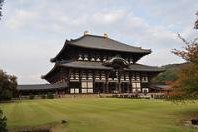
I visited this WHS in October 2009. The several Buddhist monuments in the Nara prefecture are some of the oldest wooden structures in the world. There are deer grazing freely in the nearby gardens making this site a heavenly place to visit.
Keep reading 0 comments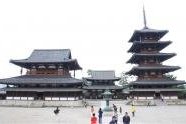
On my trip to Kyoto and Nara, I spend a half day visiting Horyu ji area. This complex and the buildings it comprises are considered as the oldest wooden building in the world. Erected during the 7th century, the main elements are the 5 story pagoda and the Kondo, the Golden Hall. Within one of the three parts of the complex is located a museum that displays a wealthy collection of old artefacts. Within the Golden Hall, a big sculpture in wood is erected. This site bears a great and unique testimony of the architecture in the early Japanese times.
Keep reading 0 comments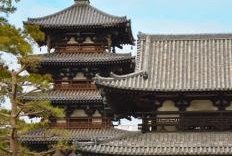
Located outside Nara, Horyu-ji is one of the most important temples of Japan as one of the oldest and well preserved original wooden structures in the world, erected by Prince Shotoku who brought Buddhism into Japan since seventh century. As one of the earliest temple in the country and supported by the Imperial family, the appearance of Horyu-ji, in my opinion, was quite interesting with many similarities of imperial palaces in Kyoto or even Chinese or Korean palaces showing vibrant cultural exchange of East Asia in ancient time.
The temple was very large and well divided into many zones by earthen walls and corridors quite similar to the Imperial Palace in Beijing which dictated eye-view to main structures of the temple. Apart from unique appearance, the temple was famous for ancient wooden pagoda and main hall which believed to be the oldest wooden buildings in the world. The pagoda was typical Japanese pagoda storing beautiful clay statues depicting the life of Lord Buddha. For the main hall, the building has unique and really beautiful dragon and monkey statues decorating the roof supporting columns.
Apart from many religious treasure of the temple's museum, another highlight of the temple was the octagonal Hall of Dream, which has a direct link with the Prince, the building was not photogenic or beautiful, but the history and unique shape was the reasons to see. Horyu-ji was also has many beautiful gardens in the sub-temple zone which make the temple on the same league with Kyoto's …
Keep reading 0 comments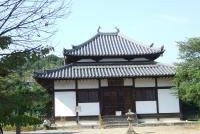
This WHS comprises two temples, the Horyuji and the Hokkiji. I reached the Horyuji temple by bus from Horyuji station. I found this temple huge, shadeless and unattractive.
After a lengthy walk I came to the Hokkiji temple, which by contrast is small and full of trees and shade. I caught a bus #97 from Hokkiji directly back to Nara station.
Keep reading 0 comments
I really enjoyed my visit to Horyu-Ji. It is one of the few temples in Japan that justifies its entrance fee - Y1000. The complex itself is quite impressive. The temple buildings are austere, but superbly constructed.
The highlight of the visit it the museum. Some of the exhibits illustrated the passage of Buddhism into Japan brilliantly - the statues I am referring to have Chinese style faces and stand in Hindu style poses! Other exhibits are breath-taking.
The staff at the visitors centre are also extremely friendly. When I visited I missed the last bus to the railway station and one of the staff gave me a lift!
The site is also relatively free from the blight which destroys the atmosphere at most Japanese temple - the ill positioned and overly large souvenir stall.
It is well worth visiting and a worthy World Heritage Site.
Truly one of the jewels in Japan's crown.
Keep reading 0 comments

